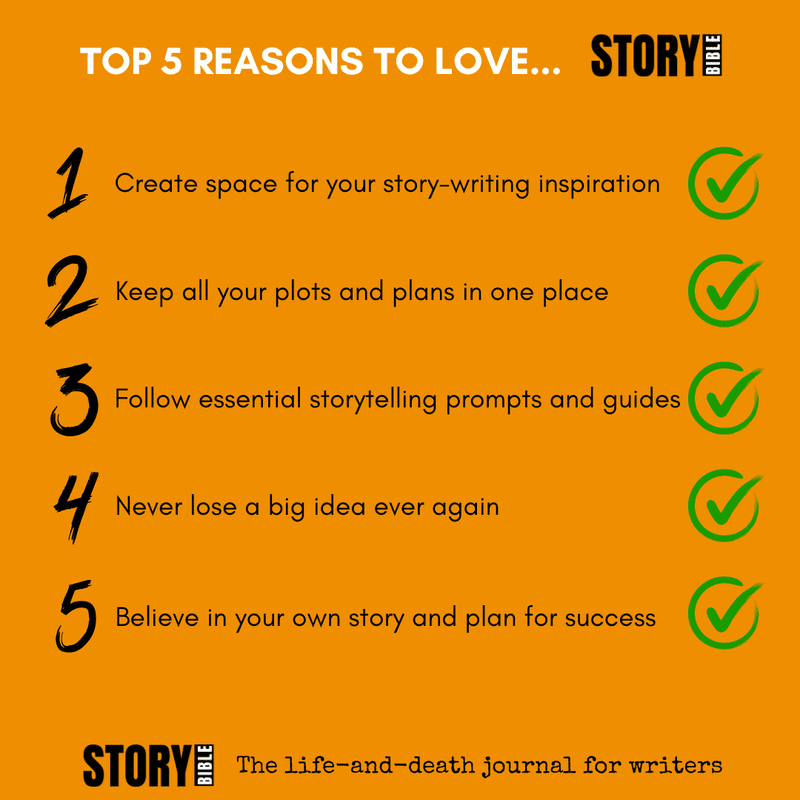Introduction to Premise
A premise is the principal idea behind your story. It is the core concept that drives the narrative. It is the foundation from which the entire story unfolds, encapsulating the plot's main focus and providing a clear direction for character development and thematic exploration. The premise outlines the central conflict or scenario around which the story revolves and sets the stage for the narrative.
It is short and sweet but writers will still pore over them for many hours. Get it right, and it will make your writing process so much easier.
For example, Harry Potter and the Philosopher's Stone's premise may be:
"An orphan raised by a horrible aunt and uncle discovers he is a wizard who must attend a school of magic and defeat the world's most evil Dark Lord."
Story Bible guides you and leaves plenty of room for you to develop your ideas.
The importance of developing a strong premise cannot be overstated. It is a guide for writers and ensures every element of the story aligns with the central idea. A well-crafted premise engages the audience from the outset and also sustains their interest by promising a compelling and coherent narrative. It is a blueprint that offers clarity and focus. It also significantly streamlines your writing process and enhances your overall storytelling experience.
Moreover, a solid premise is crucial for character development. It provides a contextual framework for characters to evolve, face challenges, and pursue their goals. By anchoring the characters' motivations and actions to the premise, writers can create more nuanced and believable personas that resonate with readers. Additionally, a strong premise helps to maintain narrative consistency, allowing for a more cohesive and immersive story.
In essence, the premise is the backbone of any story. Whether it's a novel, a screenplay, or a short story, the premise sets the tone and direction, making it an indispensable element of effective storytelling. As we delve deeper into the art of crafting a compelling premise, it becomes evident that this foundational concept is integral to creating narratives that captivate and endure.
The Role of a Premise in Storytelling
The premise of a story is not merely a starting point; it is the fundamental backbone that shapes the entire narrative. It is a guiding force, influencing every aspect of the story, from the plot and character arcs to your story's thematic elements. A well-defined premise is crucial for maintaining focus and coherence throughout the storytelling process. It encapsulates the core idea, offering a clear direction for the narrative as you write it.
In terms of plot development, the premise lays the groundwork for the sequence of events you will write in your Story Bible. It provides a framework for you to craft a compelling story, ensuring that each scene and chapter aligns with the overarching structure. By adhering to a strong premise, writers can avoid unnecessary digressions and remain committed to the central storyline.
Character arcs are also significantly influenced by the premise. The main characters' goals, motivations, and transformations should be in harmony with the foundational idea of the story. As characters evolve, their journeys should reflect the core message or question posed by the premise. This consistency helps to create well-rounded and believable characters whose actions and decisions drive the plot forward.
Thematic elements, the underlying messages or questions the story addresses, are deeply intertwined with the premise. A cohesive premise ensures that themes are woven seamlessly into the narrative, enriching the reader's experience. Themes such as love, betrayal, redemption, or justice resonate more profoundly when they stem naturally from the story's premise.
Moreover, a well-defined premise acts as a compass for writers, helping them stay on track during the creative process. It provides a reference point that can be revisited to ensure the story remains focused and coherent.
When faced with writer's block or plot challenges, return to your premise for clarity and direction, as it will make it easier to navigate complex narrative choices.
Characteristics of a Strong Premise
A strong premise is the backbone of any compelling story, setting the stage for the narrative and drawing the audience in from the outset. Key characteristics that distinguish an effective premise include concision, clarity, originality, and relevance. These elements ensure the story is engaging, unique, and resonates with its intended audience.
Firstly, concision and clarity are paramount in a strong premise. A clear premise concisely communicates the essence of the story, providing a straightforward understanding of what the narrative will entail.
For instance, the premise of George Orwell’s "1984" – a dystopian society under constant surveillance – immediately sets expectations and piques interest. Clarity helps readers quickly grasp the core conflict and the stakes involved.
Originality is another critical characteristic. An original premise introduces fresh ideas or unique perspectives that differentiate the story from existing narratives. This uniqueness can manifest in various forms, such as an unconventional setting, an innovative plot twist, or distinct character dynamics. J.K. Rowling’s "Harry Potter" series exemplifies originality through its magical world and the concept of a young wizard's journey, setting it apart from traditional coming-of-age stories.
Relevance ensures that the premise resonates with the audience’s interests, concerns, or emotions. A strong premise often addresses universal themes or contemporary issues, making the story more relatable and impactful.
For example, Suzanne Collins’ "The Hunger Games" explores themes of survival and societal control, reflecting concerns about power dynamics and inequality, thereby engaging a wide audience.
In conclusion here, a strong premise is characterized by its clarity, originality, and relevance. These elements attract and retain audience interest and provide a solid foundation for a successful story.
Examples from well-known stories like "1984," "Harry Potter," and "The Hunger Games" highlight how these characteristics can be effectively integrated to craft compelling premises that stand the test of time.
Story Bible will help you develop yours.
Common Pitfalls in Crafting a Premise
Crafting a compelling premise is a fundamental step in the storytelling process, yet many writers encounter common pitfalls that can impede the development of a successful narrative.
One frequent issue is creating an overly complex premise. While intricate stories can be engaging, a convoluted premise may confuse readers and obscure the central theme. To avoid this, it is essential to focus on clarity and simplicity, ensuring that the core idea is easily understood and effectively communicated.
Another prevalent challenge is the lack of originality. With the vast array of existing stories, it can be tempting to rely on well-trodden concepts. However, a premise that lacks novelty can feel uninspired and fail to capture the audience’s interest. Writers should strive to develop premises with unique elements or fresh perspectives, distinguishing their work from existing narratives.
Story Bible has plenty of space for you to brainstorm ideas and record sources of inspiration as you develop your premise.
Furthermore, some premises do not support a full narrative, leading to underdeveloped stories. A premise should have enough depth and potential to be expanded into a complete story with compelling characters, a coherent plot, and satisfying resolutions. Writers should evaluate their premises to ensure they offer sufficient material for a full narrative arc. This can be achieved by outlining the story and examining whether the premise provides a solid foundation for character development and plot progression.
To mitigate these pitfalls, writers should regularly review and refine their premises. Seeking feedback from peers or mentors can provide valuable insights and help identify potential weaknesses. By focusing on clarity, originality, and narrative potential, writers can craft strong premises that serve as the cornerstone for engaging and memorable stories.
Top Tip #1: Keep It Simple and Focused
When crafting the premise of a story, simplicity and focus are paramount. A clear and concise premise serves as the backbone of any narrative, ensuring that the story remains coherent and directionally sound. A well-defined premise not only helps writers stay on track but also makes it easier for readers to grasp the essence of the story.
It is crucial to distill the premise down to its most essential elements. This can be done by asking fundamental questions: What is the story about? Who are the central characters? What is the primary conflict or goal?
Strip away extraneous details and focus on the core of the narrative. For example, instead of a convoluted explanation, a premise like "A young girl discovers her hidden magical powers and must save her village from a dark curse" is direct and easily comprehensible.
Maintaining focus is equally important. A focused premise prevents the story from wandering into tangential or unrelated subplots that could detract from the main storyline. Writers should always keep the central conflict or goal in mind and ensure that every scene and character development contributes towards resolving it.
Techniques such as creating a premise statement or a logline are essential tools. A premise statement succinctly encapsulates the story in one or two sentences, while a logline provides a brief, captivating summary designed to hook the audience.
By keeping the premise simple and focused, writers can lay a solid foundation for their story, facilitating a more structured and engaging narrative. This approach enhances clarity and coherence and makes your writing process more efficient and enjoyable.
Top Tip #2: Ensure It’s Compelling and Interesting
Crafting a compelling and interesting premise is fundamental to captivating your audience from the start.
To achieve this, your premise should incorporate elements that spark curiosity and maintain engagement. One effective strategy is to introduce conflict early. Conflict serves as the driving force of your story, providing characters with obstacles to overcome and thus making the narrative dynamic and emotionally resonant. Whether the conflict is internal or external, it should be significant enough to affect the characters’ lives and relatable enough for the audience to invest in the outcome.
Another crucial aspect is to establish the high stakes involved. High stakes intensify the drama and urgency of the story, compelling the audience to care about the resolution. The stakes could be personal, such as a character’s emotional well-being or relationships; or larger-scale, like the survival of a community or the fate of the world. Well-defined stakes ensure the audience understands what is at risk and why they should be concerned about the story’s progression.
Incorporating unique elements can also elevate your premise, making it stand out in a crowded field. Unique elements might include an unusual setting, a distinctive narrative voice, or a novel twist on a familiar trope. These elements add originality and freshness to your story, making it more memorable and engaging for the audience. For instance, consider a detective story set in a futuristic world where crimes are solved using advanced technology. This twist on a classic genre can intrigue readers who are familiar with traditional detective tales but are looking for something new.
To illustrate, consider the premise of George Orwell’s "1984": a dystopian future where a totalitarian regime surveils and controls every aspect of life. The conflict is immediate and pervasive, the stakes are the loss of individual freedom and identity, and the setting is unique and richly detailed. These elements combine to create a premise that is compelling and thought-provoking, drawing readers into the narrative.
In summary, ensuring your premise is compelling and interesting involves integrating conflict, stakes, and unique elements. These strategies will help you craft a story that captures and sustains the audience’s attention.
Top Tip #3: Align It with Your Story’s Theme
In the art of storytelling, alignment between the premise and the story’s theme plays a pivotal role in crafting a cohesive and impactful narrative. The premise and theme are intertwined, where the premise sets the foundation and the theme provides the overarching message. Ensuring that these elements are in harmony can significantly enhance the reader's experience and the story's overall effectiveness.
To begin with, the premise should naturally support and enhance the story's central message. For instance, if the theme revolves around the resilience of the human spirit, the premise should introduce a scenario that challenges this resilience, allowing the theme to be explored and developed throughout the narrative. This alignment ensures that every plot point and character development resonates with the core theme, creating a unified and compelling storyline.
Moreover, a well-aligned premise and theme facilitate deeper engagement from the audience. Readers are more likely to connect with and reflect on the story when they perceive a clear and consistent message. This connection can evoke emotional responses, provoke thought, and leave a lasting impact, making the story memorable and meaningful.
To achieve this alignment, writers should continuously evaluate the premise against the theme during the writing process. Asking questions like, "Does this premise adequately set the stage for my theme?" and "Are the story developments reinforcing the central message?" can help maintain this critical alignment. Additionally, considering the symbolic and metaphorical layers of both the premise and theme can add depth and richness to the narrative.
Ultimately, the synergy between the premise and the theme is crucial for delivering a story that is not only coherent but also powerful and resonant. By ensuring that these elements are aligned, writers can craft narratives that are both engaging and thought-provoking, leaving a lasting impression on their audience.
Conclusion: The Power of a Well-Crafted Premise
In conclusion, the significance of a well-crafted premise in storytelling cannot be overstated. A strong premise is the backbone of any compelling narrative, providing a clear direction and a solid foundation upon which the entire story is built. Throughout this blog post, we have explored the essential components of a premise and offered practical tips for developing one that captivates and engages readers.
A well-defined premise ensures that the story remains focused and coherent, allowing writers to weave intricate plots and develop rich, multidimensional characters without straying from the core idea. It sets the stage for conflict and resolution, driving the narrative forward while maintaining the audience's interest. By taking the time to develop a premise, you can create stories that entertain and resonate deeply with their readers.
Tips for crafting a compelling premise include: identifying the central conflict, ensuring the premise is concise yet evocative, and testing its potential through feedback and iteration. These steps are crucial in refining the initial concept and transforming it into a robust foundation for the story. By adhering to these guidelines, writers can avoid common pitfalls and enhance the overall quality of their narratives.
Ultimately, a well-crafted premise is a powerful tool in the storyteller's arsenal. It lays the groundwork for a narrative that is both engaging and memorable, providing the clarity and direction needed to bring the writer's vision to life. Story Bible encourages writers to invest the necessary time and effort into developing their premises, recognizing that this foundational element is key to the success of any story. By doing so, they set themselves on a path to creating stories that captivate, inspire, and leave a lasting impact on their readers.








